Using the European Southern Observatory’s Very Large Telescope (ESO’s VLT), astronomers have revealed the closest pair of supermassive black holes to Earth ever observed. The two objects also have a much smaller separation than any other previously spotted pair of supermassive black holes and will eventually merge into one giant black hole.
Located in the galaxy NGC 7727 in the constellation Aquarius, the supermassive black hole pair is about 89 million light-years away from Earth. Although this may seem distant, it beats the previous record of 470 million light-years by quite some margin, making the newfound supermassive black hole pair the closest to us yet.
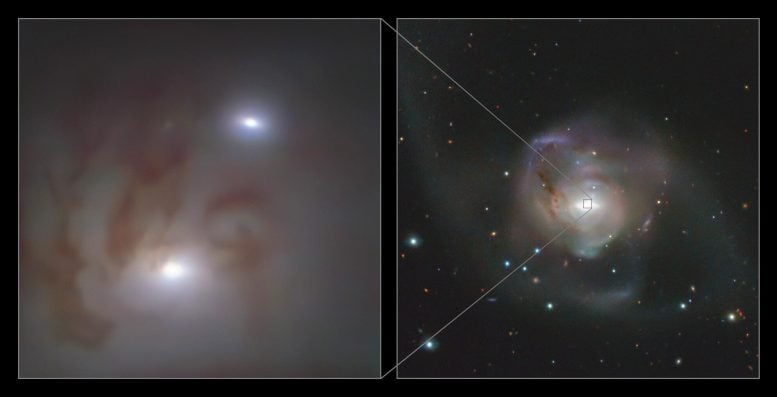
This image shows close-up (left) and wide (right) views of the two bright galactic nuclei, each housing a supermassive black hole, in NGC 7727, a galaxy located 89 million light-years away from Earth in the constellation Aquarius. Each nucleus consists of a dense group of stars with a supermassive black hole at its center. The two black holes are on a collision course and form the closest pair of supermassive black holes found to date. It is also the pair with the smallest separation between two supermassive black holes found to date — observed to be just 1600 light-years apart in the sky. The image on the left was taken with the MUSE instrument on ESO’s Very Large Telescope (VLT) at the Paranal Observatory in Chile while the one on the right was taken with ESO’s VLT Survey Telescope. Credit: ESO/Voggel et al.; ESO/VST ATLAS team. Acknowledgment: Durham University/CASU/WFAU
Supermassive black holes lurk at the center of massive galaxies and when two such galaxies merge, the black holes end up on a collision course. The pair in NGC 7727 beat the record for the smallest separation between two supermassive black holes, as they are observed to be just 1600 light-years apart in the sky. “It is the first time we find two supermassive black holes that are this close to each other, less than half the separation of the previous record holder,” says Karina Voggel, an astronomer at the Strasbourg Observatory in France and lead author of the study published online today (November 30, 2021) in Astronomy & Astrophysics.
Using the ESO’s Very Large Telescope, astronomers have revealed the closest pair of supermassive black holes to Earth ever observed. This video summarizes the discovery.
“The small separation and velocity of the two black holes indicate that they will merge into one monster black hole, probably within the next 250 million years,” adds co-author Holger Baumgardt, a professor at the University of Queensland, Australia. The merging of black holes like these could explain how the most massive black holes in the Universe come to be.
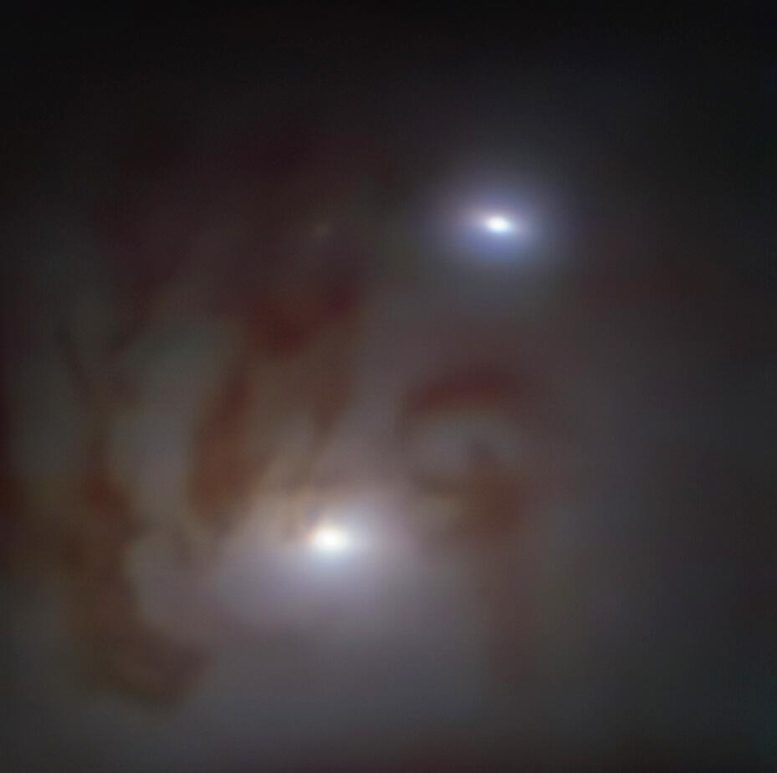
Close-up view of the two bright galactic nuclei, each housing a supermassive black hole, in NGC 7727, a galaxy located 89 million light-years away from Earth in the constellation Aquarius. Each nucleus consists of a dense group of stars with a supermassive black hole at its center. The two black holes are on a collision course and form the closest pair of supermassive black holes found to date. It is also the pair with the smallest separation between two supermassive black holes — observed just 1600 light-years apart in the sky. The image was taken with the MUSE instrument on ESO’s Very Large Telescope (VLT) at the Paranal Observatory in Chile. Credit: ESO/Voggel et al.
Voggel and her team were able to determine the masses of the two objects by looking at how the gravitational pull of the black holes influences the motion of the stars around them. The bigger black hole, located right at the core of NGC 7727, was found to have a mass almost 154 million times that of the Sun, while its companion is 6.3 million solar masses.
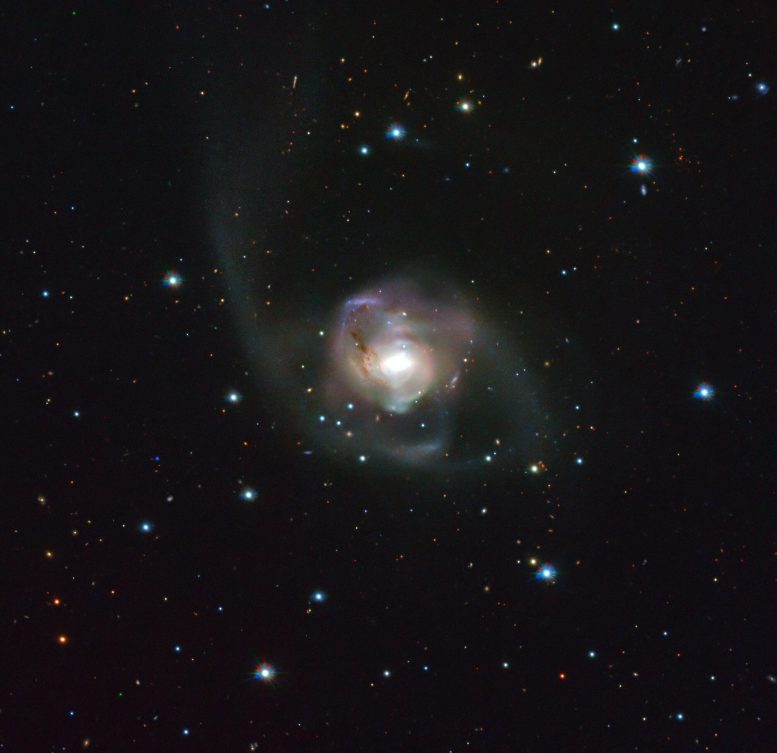
Just as people at a busy crossroad may accidentally bump into each other, so too can galaxies in the Universe! But in this case, the outcome is more dramatic than a small nudge. When two galaxies clash, they merge into each other, giving birth to a new, bigger one. One example is the NGC 7727 galaxy, shown in this image from ESO’s VLT Survey Telescope (VST) in Chile.
Located 89 million light-years away from Earth in the constellation Aquarius, NGC 7727 is believed to be the result of a clash between two galaxies that occurred about one billion years ago. The consequences of this tremendous cosmic bump are still evident in the peculiar, irregular shape of NGC 7727 and the streams of stars in its outer regions. The image was taken in visible light as part of the VST-ATLAS survey. The goal of the survey is to map a vast region of the Southern Sky — so large you could fit about 19,000 full moons in it! By studying the galaxies in this region, astronomers aim to shed new light on the nature of dark energy, the mysterious force permeating the Universe and causing its accelerating expansion. Credit: ESO/VST ATLAS team. Acknowledgment: Durham University/CASU/WFAU
It is the first time the masses have been measured in this way for a supermassive black hole pair. This feat was made possible thanks to the close proximity of the system to Earth and the detailed observations the team obtained at the Paranal Observatory in Chile using the Multi-Unit Spectroscopic Explorer (MUSE) on ESO’s VLT, an instrument Voggel learned to work with during her time as a student at ESO. Measuring the masses with MUSE, and using additional data from the NASA/ESA Hubble Space Telescope, allowed the team to confirm that the objects in NGC 7727 were indeed supermassive black holes.
This animation gives an insight into the method astronomers used to uncover a pair of supermassive black holes lurking 89 million light-years away from Earth in the NGC 7727 galaxy — and to measure their masses. The pair is the closest found to date, both with regards to the distance to Earth and the distance between the two supermassive black holes. Astronomers studied the spectra of the bright stars around each of the black holes using the MUSE instrument on ESO’s Very Large Telescope (VLT). More massive black holes have a stronger gravitational pull on the stars around them, causing them to move faster. This effect is reflected in the spectra of the stars, with the spectral lines being broader if the stars are moving faster. By measuring the width of the spectral lines for the groups of stars surrounding each black hole in the pair, astronomers calculated the masses to be about 154 million and 6.3 million times that of the Sun. Credit: ESO/L. Calçada; VST ATLAS team; Voggel et al.
Astronomers suspected that the galaxy hosted the two black holes, but they had not been able to confirm their presence until now since we do not see large amounts of high-energy radiation coming from their immediate surroundings, which would otherwise give them away. “Our finding implies that there might be many more of these relics of galaxy mergers out there and they may contain many hidden massive black holes that still wait to be found,” says Voggel. “It could increase the total number of supermassive black holes known in the local Universe by 30 percent.”
This video takes us to NGC 7727, a galaxy located 89 million light-years away from Earth in the constellation Aquarius and home to the closest pair of supermassive black holes found to date. The pair is also the one with the smallest separation between two supermassive black holes — observed to be just 1600 light-years apart in the sky. Each of the two black holes is located at the center of one of the two bright nuclei in NGC 7727 visible in the final part of the video. The two black holes are on a collision course, doomed to crash together and merge into one giant black hole probably within the next 250 million years. The close-up view of the central region of NGC 7727 and its two nuclei was taken with the MUSE instrument on ESO’s Very Large Telescope (VLT) at the Paranal Observatory in Chile. Credit: ESO/L. Calçada; N. Risinger (skysurvey.org); Digitized Sky Survey 2; VST ATLAS team; Voggel et al. Music: Azul Cobalto
The search for similarly hidden supermassive black hole pairs is expected to make a great leap forward with ESO’s Extremely Large Telescope (ELT), set to start operating later this decade in Chile’s Atacama Desert. “This detection of a supermassive black hole pair is just the beginning,” says co-author Steffen Mieske, an astronomer at ESO in Chile and Head of ESO Paranal Science Operations. “With the HARMONI instrument on the ELT we will be able to make detections like this considerably further than currently possible. ESO’s ELT will be integral to understanding these objects.”
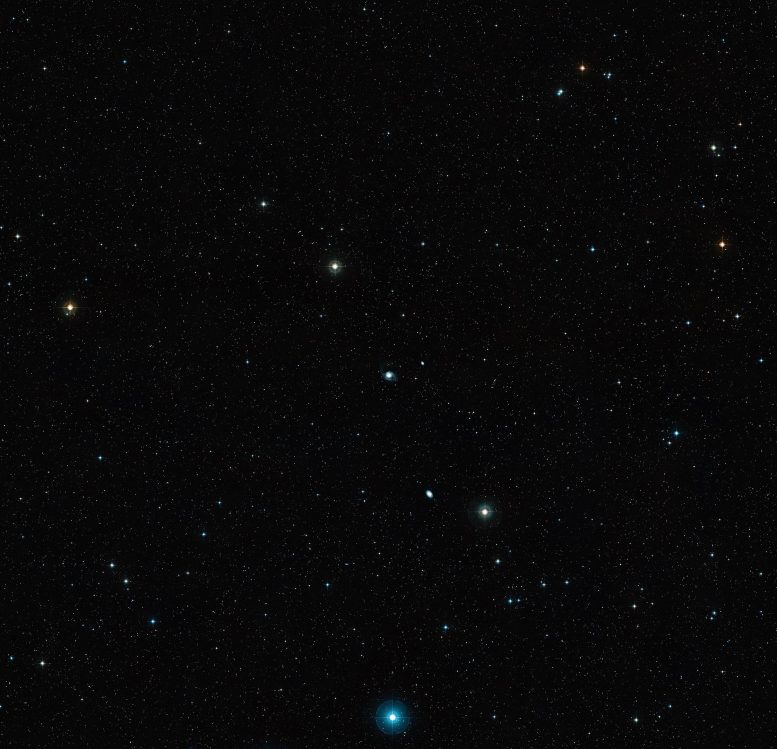
This image from the Digitized Sky Survey (DSS) shows the region of the sky around NGC 7727, a galaxy located 89 million light-years away from Earth in the constellation Aquarius. The galaxy is the bright spot in the center. NGC 7727 is home to the closest pair of supermassive black holes to Earth found to date. It is also the pair with the smallest separation between two supermassive black holes — observed to be just 1600 light-years apart in the sky. Credit: ESO/Digitized Sky Survey 2. Acknowledgment: Davide De Martin
Reference: “First Direct Dynamical Detection of a Dual Super-Massive Black Hole System at sub-kpc Separation” by Karina T. Voggel, Anil C. Seth, Holger Baumgardt, Bernd Husemann, Nadine Neumayer, Michael Hilker, Renuka Pechetti, Steffen Mieske, Antoine Dumont and Iskren Georgiev, 11 February 2022, Astronomy & Astrophysics.
DOI: 10.1051/0004-6361/202140827
The team is composed of Karina T. Voggel (Université de Strasbourg, CNRS, Observatoire astronomique de Strasbourg, France), Anil C. Seth (University of Utah, Salt Lake City, USA [UofU]), Holger Baumgardt (School of Mathematics and Physics, University of Queensland, St. Lucia, Australia), Bernd Husemann (Max-Planck-Institut fu¨r Astronomie, Heidelberg, Germany [MPIA]), Nadine Neumayer (MPIA), Michael Hilker (European Southern Observatory, Garching bei Mu¨nchen, Germany), Renuka Pechetti (Astrophysics Research Institute, Liverpool John Moores University, Liverpool, UK), Steffen Mieske (European Southern Observatory, Santiago de Chile, Chile), Antoine Dumont (UofU), and Iskren Georgiev (MPIA).

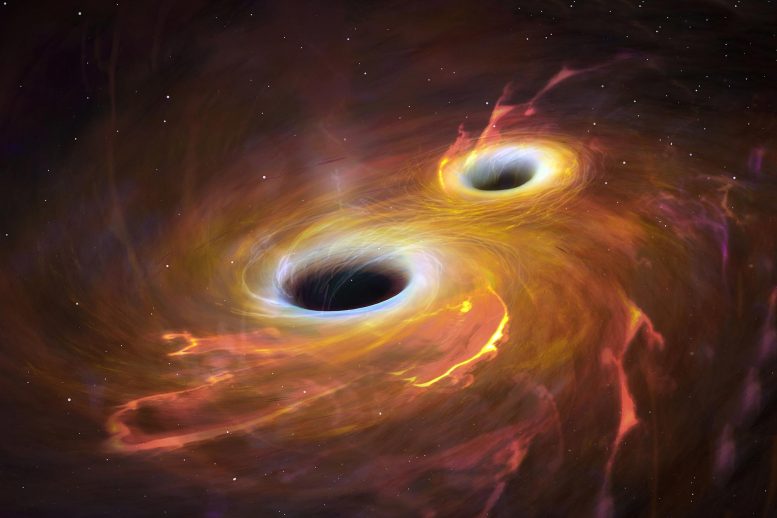





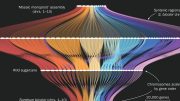


Very Interesting.
Two Supermassive Black Holes are only 89 million light years from earth in 250 million years. The assumptions are time is linear. In the quantum world time can flow in both directions.
A Black Holes Consumes all matter in its field of influence. When two Bllack Holes ( about which we know very little) are on a collission course, why do we assume that the only likelihood is it will form a larger Black Hole? Is it possible thhat these Black Holes have Polarity? If both have either Possitive or negative Polarity these two supermassive black holes may repel each other. However, if they have unlikepolarity, they may attract each other and merge to become a Much Larger Super – Super Massive Black Hole.
Black Holes are still a black box.
Views expressed are personal and nt binding on anyone.
The assumption time is linear from our frame of reference regarding these black holes is reasonable. Black holes do not ‘consume all matter in their area of influence’. Swap the sun with a similar mass black hole and our orbit wouldn’t change. Two black holes that collide either form an area of space that has even more mass at densities such that a black hole forms, so a black hole that is larger, will form. Yes, a black hole could have charge. However, it would quickly lose that charge as oppositely charged particles would be pulled on preferentially.
Black holes are not black boxes – they’re much more spherical than that. 🙂
Earth around 26,660 light-years from Sagittarius A* the black hole at the center of our galaxy. That is the nearest Black Hole to Earth.
Suvi mechanism techson morif
Can we please realize already that we have no actual clue of whats going on in the universe, and our job until everything goes kaput is to be nice to one another? Maybe then, hopefully, you’ll die happy. In an instant.
These are practically on our doorstep! The government needs to make preparations! We need Anderson shelters!
If we are observing this from earth, then it has happened a long time ago as it is 89 million light-years away. We are witnessing something that has already occurred, most likely. It is not real time.
There may be ripple effects from this event that we may not experience for millions of years. Wouldn’t it make sense to observe a linear path back to earth to determine if there has been any effects from this union?
Just some thoughts. I mean, I could be wrong. I try to stay in tune to layman’s astrophysics the best any can.
NĢC 7727 pair of binary galaxies have a common center of gravity.
Exactly this is a single galaxy now,with two super massive black holes.The larger SMBH is functioning as the main identity while the other one is simply acting as auxiliary.
Disclaimer: I’m no scientist at all, but i do love it. It’s very interesting to me that they are considered black holes with so much light of other galaxies compiled in it. I wonder if the theory of relativity is in play and if we map all 30 found black holes over history would we find any historical events on earth that correlates.
Black holes are so called since light doesn’t come out of them.
Theory of Relativity is in play. Black holes were predicted by General Theory of Relativity.
Earth is too puny and too far from any of the blackholes to be able to affect anything about those Black holes.
They are 89 mil ly away from earth & they are 1600 mil ly away from eachother. Isn’t Sag A* closer to one of them. Am I missing something?
The Universal Map shows a great density of “Dark Matter” all along the outer boundary. Since there is no source of light (other universes) out beyond those lines, is it possible that most of that Dark Matter could be Black Holes that were released during the Big Band (Bomb explosion). With no source of external light to ‘Micro Lens’ we will never know fore sure.